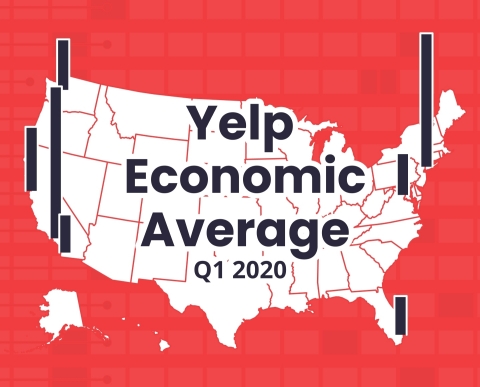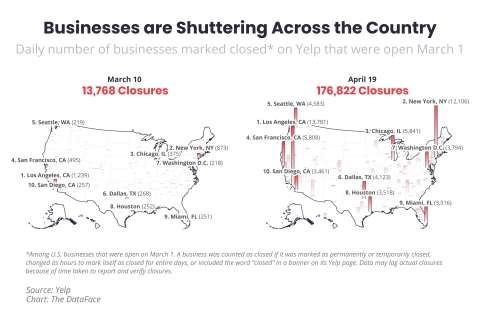SAN FRANCISCO--(BUSINESS WIRE)--Yelp Inc. (NYSE: YELP), the company that connects people with great local businesses, today released first quarter data for the Yelp Economic Average (YEA) report, a benchmark of local economic strength in the U.S. Given the unprecedented changes brought by the coronavirus (COVID-19), the report has been adapted to reveal the dramatic shifts we’re currently seeing in local economies through a variety of indicators since the start of 2020. YEA found that business closure rates rose by 200% or more in metros and states across the U.S and consumer interest in local businesses fell, by 50% or more in many categories, in a span of two weeks. The report also observed that some businesses saw a surge in interest, including fitness and exercise equipment (up 437% in seasonally adjusted share of relevant page views, reviews, and photos since March 10), community-supported agriculture (up 407%), and guns and ammo (up 191%).
YEA reflects data from millions of local businesses and tens of millions of users on Yelp’s platform. To accommodate this past quarter’s report, Yelp measured business closures; consumer interest, behavior, searches and reviews; and perspective on how local economic impact compared to previous natural disasters in the U.S. According to researchers, Yelp provides a timely and accurate measure of a huge swath of the economy that is often missed by many major indicators.
“In 15 days, the economy transformed as much as it had in our prior 15 years of operation, combined,” said Carl Bialik, Yelp’s data science editor. “This quarter has been unlike any other as businesses suddenly closed nationwide, consumer interest plummeted, businesses overhauled their business models, and workers and consumers changed lifelong habits overnight. Between March 10 to March 21, one of the hardest hit categories was bars and other nightlife businesses, which declined in consumer interest by 81%. Salons and other beauty businesses were down 77%, hotels and other travel businesses were down 75%, and restaurants were down 52%.”
Business Closures Rise Nationwide, Across Metros and Categories
YEA found the rate of closures nationwide, and so many other indicators of local economic strength, sharply turned during the second and third weeks of March as warnings gave way to shelter-in-place orders and other governmental measures to curb the pandemic. On or around March 16, closure rates increased by two to four times, and have remained at that new, elevated rate.
Since March 1, more than 175,000 businesses have been marked on Yelp as shut down, temporarily or permanently. The Los Angeles metro area saw the largest number of closed businesses, followed by New York and Chicago. Seattle and San Francisco have had the highest rate of business closures, as a share of all businesses, among major metros, while Philadelphia and Miami have the lowest rate of business closures among major metros. The businesses marked as closed include more than 48,000 shopping establishments, 30,000 restaurants, and 24,000 spas and other beauty businesses.
The Local Economic Impact Equivalent of Several Major Hurricanes
YEA analyzed how consumer interest in local businesses during COVID-19 compared to the economic impact of other U.S. natural disasters. The New York metro area experienced the equivalent of eight Hurricane Sandys. The Houston metro area was hit by the economic equivalent of four Hurricane Harveys, Miami by four Irmas, and New Orleans by four Isaacs. The report found that hurricanes were the closest precedents in economic impact, with the largest immediate effect among other economic shocks.
Consumers Moved Fast, Often Ahead of Their Governments
Consumer activity turned steeply downwards on (or around) March 11 across nearly all 50 states no matter what measures local governments had or had not implemented at that time. Notably, consumers often were out in front of their leaders: New Yorkers’ search behavior started to reflect the new reality on March 11, two days before Californians’ and 11 days before New York Gov. Andrew Cuomo ordered his state’s residents to stay home.
Business Owners Adapted, and Some Saw Demand Increase
The data showed how some businesses were unusually well-suited to meet the needs of customers stuck at home, and how others adapted with virtual services, delivery, and even shifts to their business model. Fitness & exercise equipment (up 436% in seasonally adjusted share of relevant page views, reviews, and photos since March 10), cosmetic and beauty companies (up 139%), pizzerias (up 71%) and chicken-wing joints (up 84%) were all able to quickly pivot to abide by stay-at-home orders.
As people stopped dining out at restaurants, the ratio of searches for dining-in to dining out increased by 300 times in a few weeks. At the same time, many high-end restaurants and cocktail bars quickly pivoted to prepare takeout options. Other businesses such as photographers, art teachers, fitness instructors, and party planners all have found new ways to continue to operate while still respecting social distancing measures.
Consumer Behavior Was Consistent Across Political Parties
Although some polls have shown Americans’ attitude toward the virus differed by political affiliation, our data suggests otherwise. By state, metro, or county, businesses and consumers responded in much the same way, irrespective of local circumstances, including which political party holds sway over local offices or how the state voted in the 2016 presidential election.
Support for Local Businesses Surfaces in Searches and Reviews
Consumer behavior changed as rapidly as businesses have had to adapt. The report found that searches for flowers were at near-Valentine’s Day levels — with particularly elevated interest in the Northeast and Great Lakes regions. People have also started noting the health measures taken by establishments and by their fellow consumers with mentions of sanitizer, gloves, and phrases related to keeping physical distance from each other rising in the second week of March. Mentions of masks rose steeply after the federal government recommended their usage for all Americans, but the rate of review mentions had been rising steadily beforehand.
Reviewers also increased their usage of several phrases touching on support of businesses: supporting restaurants, supporting their favorite businesses, and supporting locally. Physical-distancing requirements led to the steep decline in mention of service staff, dropping off to mentions by under 2% of reviewers from a typical rate of over 10%. Consumers are now interacting with service staff less and instead adopting other ways of transacting, such as curbside pick-up or contact-less delivery. By the end of March, roughly one in six reviewers each day mentioned phrases related to the coronavirus at a high rate rarely seen for other types of phrases in Yelp’s reviews.
See all of our Yelp Economic Average reports, how we calculated Q1 2020 YEA, and other resources at yelpeconomicaverage.com. Yelp is regularly updating its Coronavirus Economic Impact Report to outline how local economies continue to fare in these uncertain times.
Please find more assets and images here. For more information and Yelp’s latest company metrics, visit: https://www.yelp-press.com/company/fast-facts/default.aspx
Methodology
Business Closures
On each date, starting with March 1, we count U.S. businesses that were open on March 1 and were closed on that day. Closure can be permanent or temporary, and is signaled by a business owner marking the business as closed, including by changing its hours or through a COVID-19 banner on its Yelp page. Closure counts are likely an estimate of the businesses most impacted, with many others not counted because they remain open with curtailed hours and staffing, or because they have not yet updated their Yelp business pages to reflect closures. Closures are counted by state, metro area, and category; some businesses are in more than one category. One-day closures that appear to be unrelated to the pandemic, such as for Easter, are not counted.
Consumer Interest Changes By Political Party
We measure consumer interest by page views, and political affiliation by 2016 presidential election results, using data from MIT Elections Data and Science Lab. We aggregate consumer interest and political affiliation at the county level and then by business category. We compute the relative changes of page views with respect to March 10. Then within each category, we compare these relative changes along the temporal and the political dimensions.
When Consumers Changed Their Behavior
The turning points for consumer behavior by state is measured using seasonally adjusted daily search volume. The overall period of change is the period in which daily search volume was continuously falling. The period of rapid change shown in the chart is the period between when search volume fell to 25% below its initial level, and when it reached within 25% of the new plateau.
Local Economic Impact
We measure daily consumer interest, in terms of daily U.S. counts of a few of the many actions people take to connect with businesses on Yelp: viewing business pages or posting photos or reviews. By metro area (core-based statistical areas), we compare daily consumer interest with the level expected based on a forecast model accounting for seasonal, day-of-week, holiday, and other underlying trends.
We then use this model to identify anomalous events that cause the actual activity to deviate significantly from the expected level. The beginning of each event is defined to be one day before the day on which user activity first deviates more than 10% from the normal level. We say the event “ends” when activity has returned to roughly the expected level for several days. We start tracking the effect of the pandemic on March 9 for each location.
The total impact of the event is the total difference between expected and actual activity for the duration of the event’s impact. For example, if during a hurricane we see a daily average of 25% less activity than expected over 10 days and during the pandemic we see a daily average of 50% less activity than expected over 40 days, we would say that the pandemic had eight times the economic impact of the hurricane: twice the daily impact, for four times as many days.
Consumer Interest By Business Category
We measure daily consumer interest, in terms of seasonally adjusted daily U.S. counts of a few of the many actions people take to connect with businesses on Yelp: viewing business pages or posting photos or reviews. We start with the biggest U.S. categories by consumer actions. Among those, we select the biggest gainers and biggest decliners in terms of their seasonally adjusted share of all root category consumer actions since March 1. Then we choose representative ones to show the trend, which we’re charting from March 1 through April 19.
Searches and Reviews
We look for phrases whose frequency in daily and weekly mentions in search queries or users’ reviews changed significantly, grouping related terms. For reviews, we evaluate the increase or decrease in frequency of users who use a specific word or phrase since February 2020. For search queries, we compare frequencies of search terms to all queries over the same weeks this year and last year to identify the largest changes. We aggregate searches by state to identify trends in specific localities, and compare the frequency of mentions of celebrations to the frequency of mentions of illness or death in recent florist reviews, to understand the reasons for increased search frequency in flower delivery.
About Yelp Inc.
Yelp Inc. (www.yelp.com) connects people with great local businesses. With unmatched local business information, photos and review content, Yelp provides a one-stop local platform for consumers to discover, connect and transact with local businesses of all sizes by making it easy to request a quote, join a waitlist, and make a reservation, appointment or purchase. Yelp was founded in San Francisco in July 2004. Since then, Yelp has taken root in major metros in more than 30 countries.



